Magelind, a free knitting pattern from Knitty.com. Free knitting pattern for a DETAILS HERE. This pattern was named by a Neural Net.
INTRODUCTION
Magelind
 by Kate Atherley
by Kate Atherley
![]()
Lacy socks in a cool bamboo-based yarn are just the thing for spring. And if the weather isn't quite up to it yet, they look excellent over a pair of tights.
The leg is a little shorter than you might be used to wearing but it's spring! Go for it!
These have my favourite sock details, of course: worked top down, with my heel turn of choice, and a no-graft toe. The square heel allows you to easily continue the reinforcement down into the turn.
 model: Kate Atherley
model: Kate Atherley
 photos: Amy Singer
photos: Amy Singer
SIZE
Adult XS[S, M, L, XL]
FINISHED MEASUREMENTS
Foot circumference: 6[7, 8, 9, 10] inches/ 15[18, 20.5, 23, 25.5] cm
Leg length: 5.5 inches/14 cm
Foot length: adjustable to preference
Note: Because of the wrapped sts, the lace pattern doesn't stretch as much as stockinette (or a standard lace pattern) does; choose a size with approximately 0.5 inch/1.5 cm negative ease in the foot circumference.
MATERIALS
Yarn
![]() Regia Premium Bamboo [45% wool, 30% viscose, 25% nylon; 437 yd/400m per 100 g ball]; color: 00020, 1 ball
Regia Premium Bamboo [45% wool, 30% viscose, 25% nylon; 437 yd/400m per 100 g ball]; color: 00020, 1 ball
Recommended needle size
[always use a needle size that gives you the gauge listed below - every knitter's gauge is unique]
![]() US #1.5/2.5mm needles for small circumference in the round: traditional or flexible DPNs, 1 long circular for magic loop, or 2 short circulars, as you prefer
US #1.5/2.5mm needles for small circumference in the round: traditional or flexible DPNs, 1 long circular for magic loop, or 2 short circulars, as you prefer
Notions
![]() yarn needle
yarn needle
GAUGE
32 sts/48 rounds = 4 inches/10 cm in stockinette stitch
PATTERN NOTES
[Knitty's list of standard abbreviations and techniques can be found here.]
This pattern creates a fraternal pair of socks. One sock has a left-leaning double decrease, the other sock has a right-leaning double decrease, creating spirals that lean in opposite directions. Use the Left charts for the first sock, and the Right charts for the second. Which you wear on which foot is up to you!
Long Tail CO
Instructions for the Long-Tail Cast On can be found here and here.
Dec-2-right: Work an ssk on the next 2 sts, and return to left needle; lift the next st on the left needle over the dec just worked, letting it drop off the needle, and return the resulting st to the right needle. 2 sts decreased.
Cluster 3 sts: *Bring yarn to front and slip next 3 sts purlwise; take yarn to the back; return the 3 sts to the left needle; repeat from * two more times, then knit the 3 sts.
Sl 1 wyib: Slip 1 st purlwise with yarn in back.
Sl 1 wyif: Slip 1 st purlwise with yarn in front.
Sl1, k2tog, psso: Slip 1 st knitwise, k2tog, then pass the slipped st over the st just worked.
Leg Pattern - Left
There's some shifting of the start of the round to keep the pattern flowing neatly. At the end of Rounds 9 and 19, remove the start of round marker if you're using one, work the first stitch of the following round and replace the marker; Rounds 10, 11, 12, 13 and 20 and 21 then start in this new position. Rounds 13 and 21 end one stitch early, at the original end of round position, restoring the original start of round.
Leg Pattern - Right
There's some shifting of the start of the round to keep the pattern flowing neatly. At the end of Rounds 9 and 19, remove the start of round marker if you're using one, work the first stitch of the following round and replace the marker. The next two rounds start in this new position. Rounds 11 and 21 end one stitch early, at the original end of round position, restoring the original start of round.
CHARTS
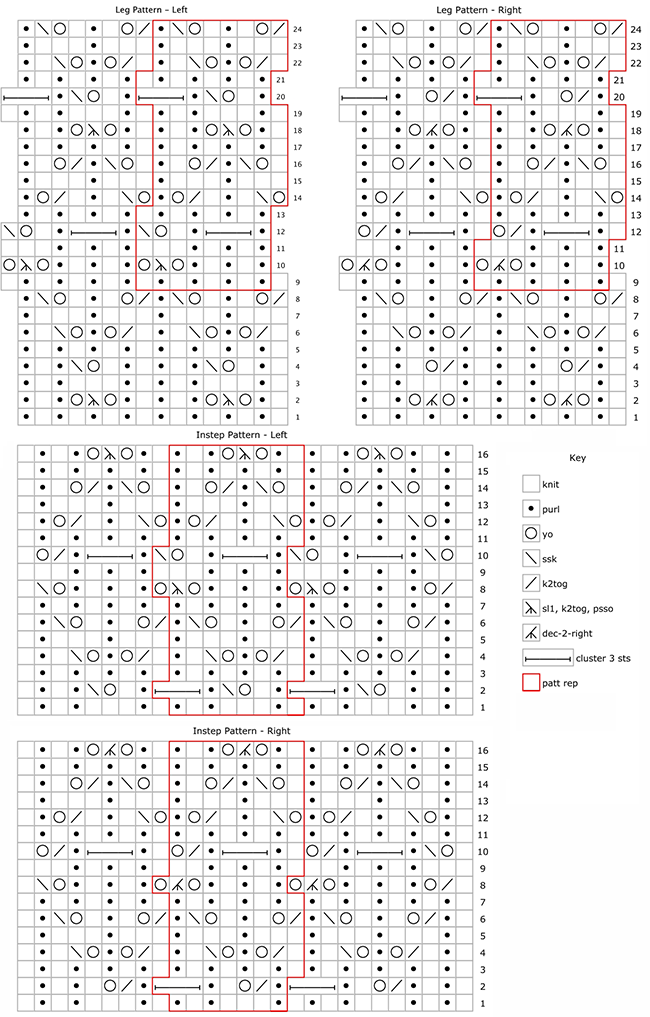
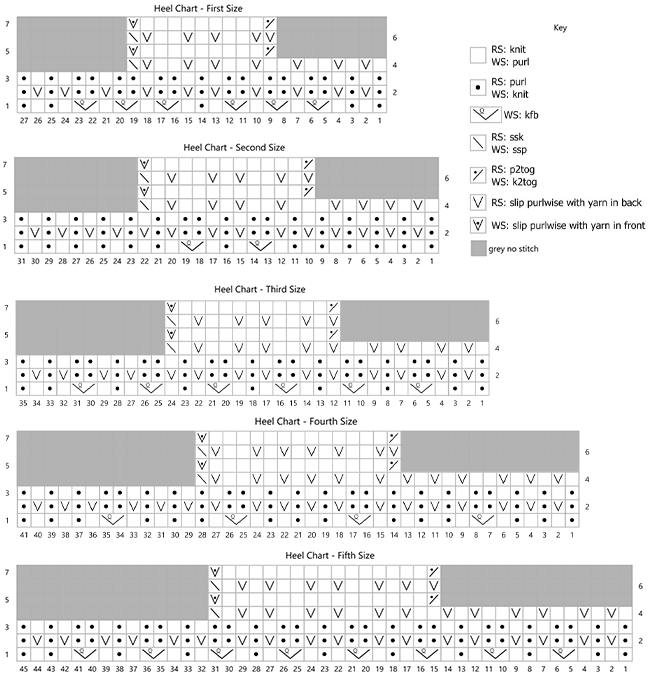
DIRECTIONS
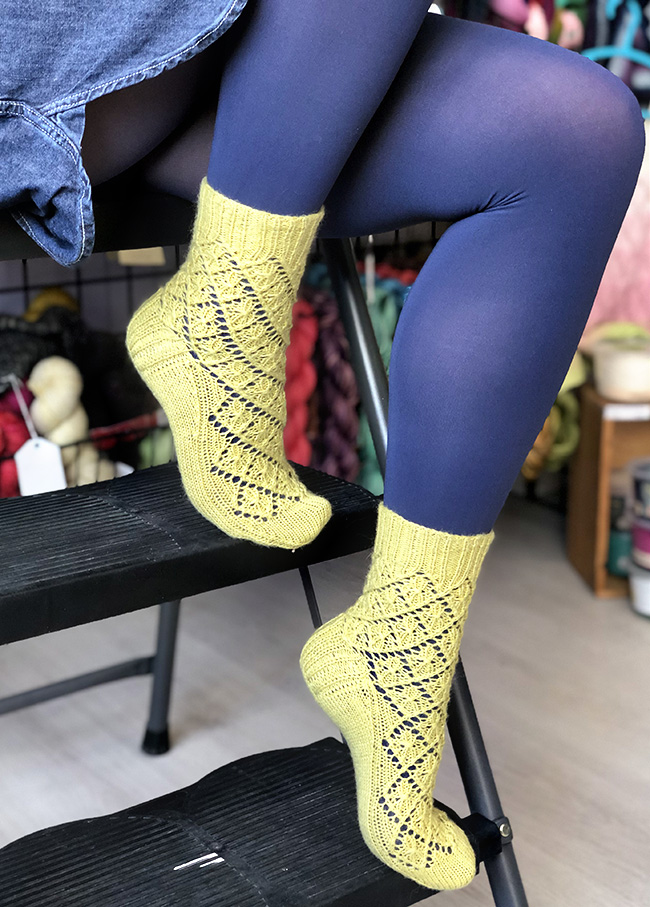
Cuff - Both Socks
Using your favorite stretchy method (Long Tail or German Twisted), CO 54[63, 72, 81, 90] sts. Distribute sts across needles as you prefer and join for working in the round.
Ribbing round: [(K1, p1) 3 times, k1, p2] around.
Work ribbing as set for 1.5 inches/4 cm. To lengthen leg, work more ribbing.
Decrease round, to adjust for lace pattern gauge: [(K1, p1) 3 times, k1, p2tog] around. 48[56, 64, 72, 80] sts.
Upper Leg round: Work appropriate Leg Pattern 6[7, 8, 9, 10] times around. Work as set until you have completed Round 24, repeat Rounds 9-24 one more time, then work Rounds 9-18 again.
Heel Flap & Turn
Transition to heel [RS]: Work across first 14[22, 22, 30, 30] sts in patt, turn.
Heel flap row 1 [WS]: Working Heel Chart for appropriate size, starting at Row 1, work back in patt. This will take you 7 sts past the original start of round. The last 27[31, 35, 41, 45] sts worked form the heel flap. Rem 27[27, 35, 35, 43] sts will be held for instep. Rearrange sts as you prefer.
Note: Do not slip stitches at the edges of the heel flap.
Heel flap row 2 [RS]: Work Heel Chart Row 2.
Heel flap row 3 [WS]: Work Heel Chart Row 3.
Repeat Heel flap rows 2-3 12[14, 16, 19, 21] more times.
To turn heel, proceed to Heel Chart Row 4, turning to work back after the decrease has been worked. Work until you have completed Heel Chart Row 6, each time turning to work back after the decrease has been worked, then Repeat Heel Chart Rows 6-7 until all heel sts have been worked, and 11[13, 14, 15, 17] sts rem for heel.
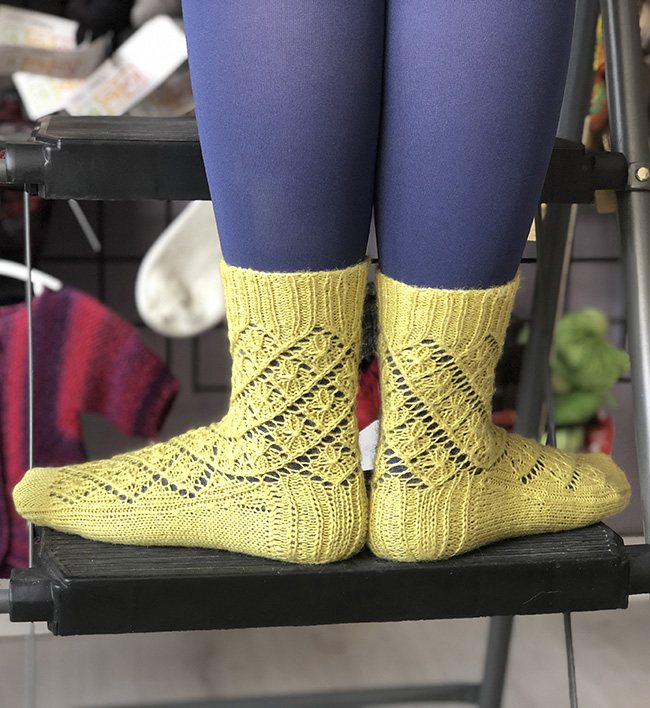
Gusset
Gusset setup round 1: Knit across 11[13, 14, 15, 17] sts of heel; with RS facing, pick up and knit 16[18, 20, 23, 25] sts along the first edge of the heel flap, 1 in every other row and then two at the top; work across 27[27, 35, 35, 43] sts of instep according to appropriate chart, working the 8-st repeat 1[1, 2, 2, 3] times; pick up and knit 16[18, 20, 23, 25] sts along the other edge of the heel flap, 1 in every other row and then two at the top; k 5[6, 7, 7, 8] from heel. This is the new start of round.
Place marker and rearrange sts as you prefer. 70[76, 89, 96, 110] sts.
Gusset setup round 1: K 6[7, 7, 8, 9] , k 15[17, 19, 22, 24] tbl, p1; work across instep in patt as set; p1, k15[17, 19, 22, 24] tbl, knit to end of rnd.
Gusset round 1: Knit to 3 sts before instep, k2tog, p1; work across instep in pattern as set; p1, ssk, knit to end of rnd. 2 sts decreased.
Gusset rounds 2-4: Work across instep in pattern as set; knit to end of round.
Repeat Gusset rounds 1-4 8[7, 9, 9, 12] more times. 52[60, 69, 76, 84] sts.
Foot
Work even in pattern as set until foot measures 1.75[2, 2.25, 2.25, 2.5] inches/ 4.5[5, 5.5, 5.5, 6.5] cm short of desired finished length. It looks tidiest if you can end with Rnd 8 or 16 of the pattern, but it's not crucial.
Transition round: Knit.

Toe
First, Third and Fifth sizes only, Initial decrease round: Knit to 1 st before instep, p1; ssk, knit to last 2 sts of instep, k2tog; p1, knit to end of round. 2 instep sts decreased.
Second and Fourth sizes only, Initial decrease round: Knit to 3 sts before instep, k2tog, p1; knit across instep; p1, ssk, knit to end of rnd. 2 sole sts decreased.
All sizes:
Knit 3 rounds.
Work the Initial decrease round for appropriate size followed by 2 even rounds. 23[27, 31, 35, 39] sts on instep, 25[29, 34, 37, 41] sts on sole.
All sizes:
Second Decrease round: Knit to 3 sts before instep, k2tog, p1; ssk, knit to last 2 sts of instep, k2tog; p1, ssk, knit to end of round. 4 sts decreased.
Work 2 even rounds.
[Work Second Decrease round followed by 1 even round] 3 times.
Work Second Decrease round only until 8[8, 9, 8, 8] sts rem.
Cut yarn and pull through final sts to secure.
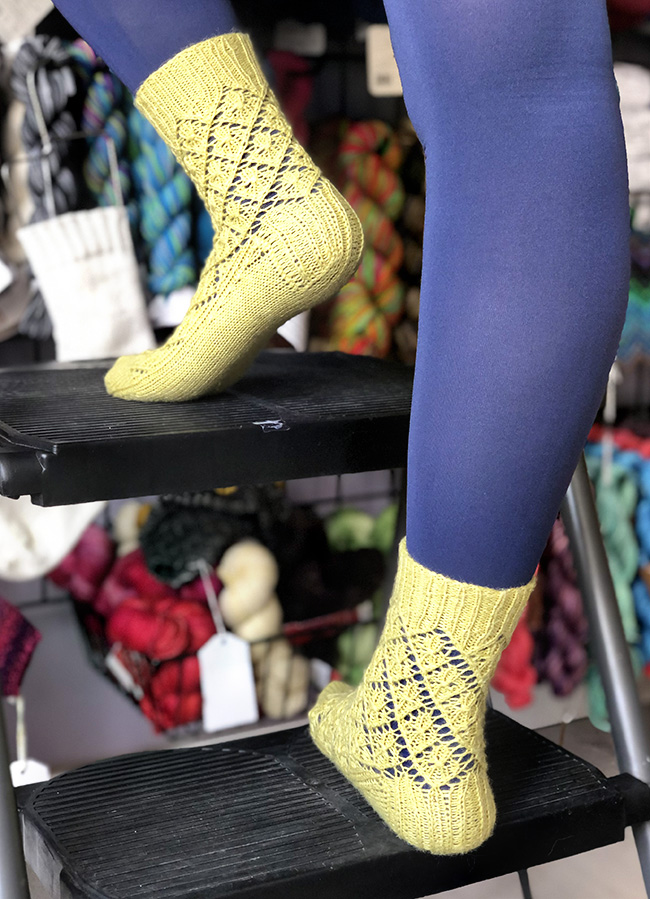
FINISHING
Wash to block and weave in ends. Sock blockers aren't necessary; the socks will stretch out nicely on your feet.
ABOUT THE DESIGNER
 Kate is rather a fan of interesting socks that fit well. Did you know she wrote a whole book about it?
Kate is rather a fan of interesting socks that fit well. Did you know she wrote a whole book about it?
You can see more of her work at her website, and on Ravelry.
Pattern & images © 2020 Kate Atherley.